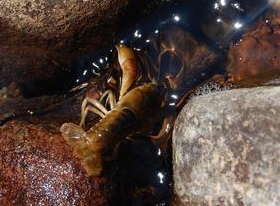 barriers have been developed to prevent invasive American signal crayfish from moving upstream and colonising important European crayfish habitat. The barriers, designed to stop crayfish but allow fish to pass, have been found to be effective where water flow rates are sufficiently high.
barriers have been developed to prevent invasive American signal crayfish from moving upstream and colonising important European crayfish habitat. The barriers, designed to stop crayfish but allow fish to pass, have been found to be effective where water flow rates are sufficiently high.Since signal crayfish were introduced into European waters in 1959, native crayfish populations have collapsed due to both competition and the transmission of ‘crayfish plague’ disease. Urgent measures are necessary if populations of native crayfish are to survive. While completely eradicating signal crayfish would be difficult, a potential alternative solution is to use barriers to stop invasion of surviving native crayfish populations.
While the use of barriers is a valuable solution to explore, it is important to preserve the connectivity of European waterways for native migratory species, as outlined in the Water Framework Directive.
Therefore any barrier to prevent the spread of signal crayfish must not affect movement of other wildlife, such as migrating fish.
This study explored how to construct an effective barrier to stop signal crayfish moving upstream, but allow the passage of fish. To optimise the design of the barrier, a model of crayfish mobility was developed based on factors affecting crayfish movement, such as muscular force and drag exerted by water currents.
A prototype barrier was then tested in a laboratory using signal crayfish taken from a German stream. Food bait was placed beyond the barrier and crayfish were subjected to a range of current speeds.
Researchers also tested the effects of changing the slope and texture of the barrier. Crayfish succeeded in walking over the barrier in 14 out of 32 experiments. When walking failed, crayfish resorted to swimming – a behaviour previously thought to be only for predator evasion. This meant that crayfish could cross the barrier at any slope or texture provided current speed was not too high, at which point the smoother and steeper barriers became harder to cross. Smooth, steep barriers can therefore be effective if the speed of the water flow is sufficient to prevent the crayfish swimming upstream. Since the barriers did not reach the water surface, they would allow fish to pass, however, the authors do highlight that further research, especially trials in a natural setting, would be needed to assess their impact on fish and other animals that live in the river bed.
Although the barriers could stop the invasion of non-indigenous crayfish, they would only partially protect against crayfish plague disease, which can be spread by fish, water birds, boats and anglers. However, the barriers would have value; if plague destroyed a native population, reintroduction of the European crayfish would still be possible if barriers have prevented signal crayfish from colonising the habitat. However, any new population could still potentially be infected, even with the barriers in place.
The researchers discuss different barrier designs and identify potential pitfalls, such as the fact that invasive crayfish are able to use small fissures between the barrier and the bank as a foothold to breach the barriers. Any barrier must also prevent access to the river bank, because crayfish can crawl over land. There may be opportunities to install barriers where existing structures, such as fish ladders, are already in place, reducing the need for separate maintenance regimes.





